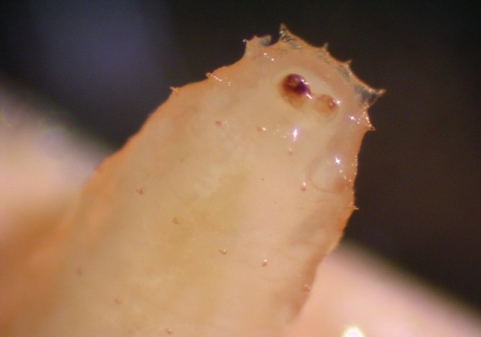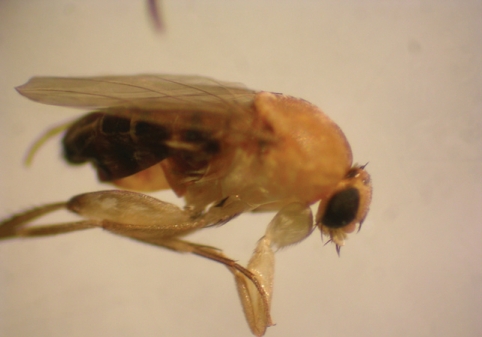INTRODUCTION
Myiasis is a term used to describe the invasion of tissues or organs of vertebrates with the larvae (maggots) of dipterous flies. It could be external or internal, and the invasion for the maggot could be obligatory, facultative, and sometimes accidental [1]. This is the first report to describe a laboratory-based diagnosis of accidental human urinary myiasis due to invasion of Megaselia scalaris (Diptera: Phoridae) in Saudi Arabia. In addition, we report the detection of protozoan motile flagellates in the larvae.
CASE RECORD
The urine sample containing 5 larvae was collected in a clean container after washing the urogenital area, from a 5-yr-old female living in Jeddah, Saudi Arabia. She complained of difficulty in urination and discomfort for several days. All symptoms disappeared on the next day of specimen collection. Two larvae were placed in 70% alcohol for identification, and then were examined under a stereo dissection binocular microscope. Another 2 larvae were cultured on a stool sample to allow development into adult flies. The fifth larva was crushed and examined microscopically as a wet mount with saline, and then certain parts were transferred onto another slide, allowed to air dry, fixed with methanol, and finally stained with 10% (v / v) Giemsa stain. Identification of larvae and adult flies was done according to keys described by previous workers [2-5].
Macroscopic examination showed that all the 5 larvae were alive, whitish in color with dark internal contents in the third terminal part. The length of larvae ranged 2.5-3.5 mm. Microscopic examination of the preserved 2 larvae under a dissection binocular microscope revealed the presence of rows of many tiny short spines on the body (Figs. 1-3). Dense, tooth-like sharp pointed spines were on the anterior part (Fig. 2). A pair of posterior spiracles is situated dorsally (Fig. 3). According to the description in previous workers, the larvae were assumed as the first and second-instar larvae of M. scalaris [2-5].
For confirmation of the identity of the fly, 2 larvae were cultured on a stool sample. On the second day, one of these larvae was clearly lager than the other. On the fourth day, the bigger larvae buried itself inside the stool except the posterior end. The color of this larva was light brown. Some soil was added to maintain humid condition and to include the possibility of sand burying phenomenon if applicable. The second larva started burying on the next day. On day 12, the first adult fly immerged (Fig. 4). This tiny fly was 1.8 mm long, with a hump-backed appearance, light brown in color with striated back and a characteristic quick jerky motion. Two days later (Day 14), the second fly immerged. According to general appearance of adult flies and the characteristic morphology of the larvae, the identity was confirmed as M. scalaris.
The fifth larva was crushed on a microscope slide, and examined as a wet preparation after adding a drop of saline and covered with a cover glass. Using light microscopy, it was possible to observe 4 motile flagellates in the ruptured gut. This part of the gut was carefully smeared onto another microscope slide, allowed to air dry, fixed with methanol, and finally stained with 10% (v / v) Giemsa stain. The size of the flagellates ranged between 30-35 µm and each flagellate was clearly consisting of a body with a nucleus and a single flagellum. The motility and morphology of the flagellates were similar to the protozoan flagellated form belonging to the family Trypanosomatidae.
DISCUSSION
Megaselia scalaris is a small hump-backed fly with characteristic rapid jerky movements on surfaces, hence the common name is the scuttle fly [3,6]. The females are highly attracted by strong odors and lay their eggs on deferent decomposing materials including feces, flesh, vegetables, and fruits.
Several previous workers reported myiasis due to M. scalaris in man, animals, and plants. Several workers reported cases of intestinal myiasis due to M. scalaris [7-9]. Hira et al. [10] described in 2004 a case of nosocomial myiasis in Kuwait caused by M. scalaris. The first report of human urogenital myiasis due to a species of Megaselia was represented in 1978 by Disney and Kurahashi [11], and then more cases were reported [12-14]. Other workers studied invasion of ticks [15], bananas [16], and snacks [17] by the larvae of M. scalaris. The use of M. scalaris specimens in forensic investigations was also documented
18,19].
Phorids can live on many types of decomposing organic matters and in the present study the larvae were reared in stool cultures; however, the stool or other materials were used by previous workers [3,7,20]. Bacterial culture plates were also found to be suitable for maintaining the larvae of Megaselia [14].
Many flagellates of the family Trypanosomatidae have been isolated from a wide range of plants, animals, and insects [21]. Flagellates of the genus Herpetomonas are usually found colonizing in the digestive tract of M. scalaris [22], so the observed flagellates in the present study could belong to that genus. We plan for a further investigation using electron microscopy and molecular techniques to confirm the identity of those flagellates. Monoxenous trypanosomatids are not believed to infect vertebrate cells. However, recent in vitro work suggested that monoxenous trypanosomatids could be potentially pathogenic to vertebrate hosts [23].
People in Jeddah, Saudi Arabia, used to see scuttle flies in different places, such as vegetable and fruit markets, toilets, and around decomposing materials. The present myiasis case is probably accidental infestation related to a lack of personal hygiene and it is likely that Megaselia adults deposited their eggs on the underwear cloths of the patient or directly in the urogenital area after being attracted by urine odor. To follow up the case, for several days later, urine specimens were collected and examined but no larvae were observed. It is possible that the occurrence of many myiasis cases much more than are reported.
To the best of our knowledge, only one paper documented the distribution of M. scalaris in Saudi Arabia [24], so we hope that in the coming future other specialized workers will study the common species of the phorid flies in Saudi Arabia.







